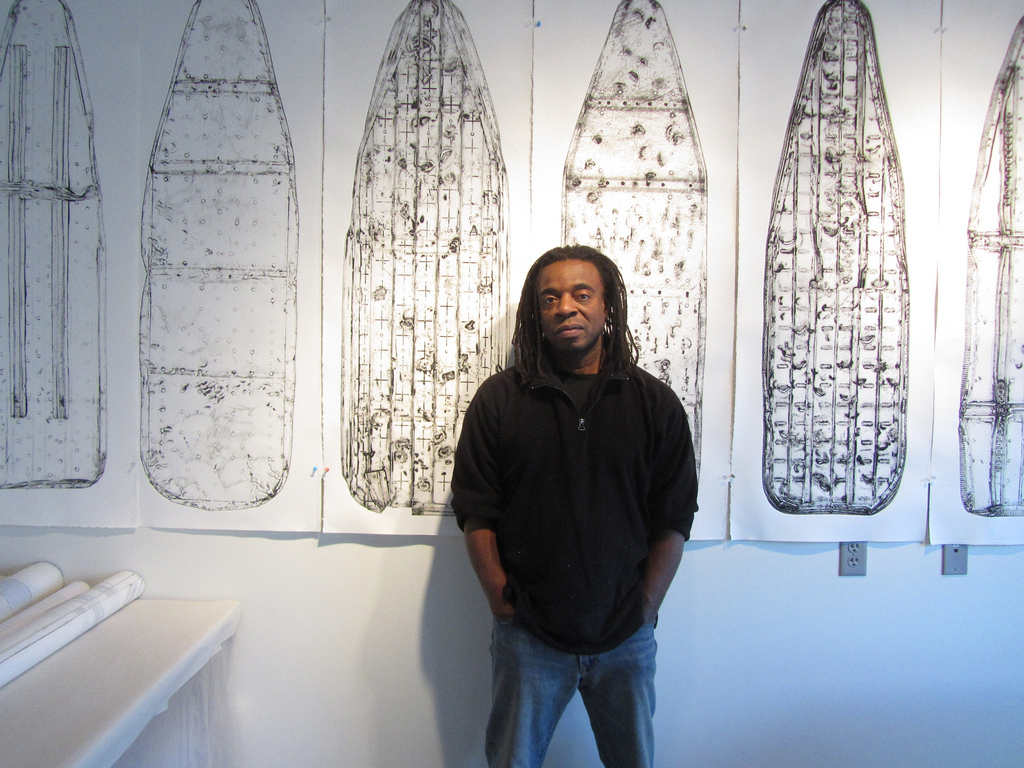
Born 1955, Somerville, New Jersey
Willie Cole didn’t set out to make art from old steam irons, hair dryers, bicycles, and high-heeled shoes. He says these and other discarded objects, which he has collected by the thousands, found him. He deconstructs them and plays with the parts until a sculpture materializes; early assemblages often referenced African or Asian forms. The hair dryers that he discovered in an abandoned factory became masks and an eight-foot mandala. An African “power” figure from 1998 employed the metal casings of twenty-three irons.1 In the early 2000s, he transformed bicycle parts into antelope-like headdresses reminiscent of those worn by Mali’s Bamana people. High heels became chairs, giant flowers, and masks; Ashley Bickerton (2016) is among the most colorful. Cole sees domestic objects as having histories to unleash. “I am interested in uncovering spirits,” he has said.2
Since the mid-2010s, Cole has been sculpting forms (chandeliers, life-size cars) from plastic water bottles while also encouraging recycling. But he is perhaps best known for his work with irons. His preoccupation began in 1988 when he saw a flattened iron on Railroad Avenue, near his longtime Newark, New Jersey, loft. To Cole, it looked like an African mask. It prompted his breakthrough assemblage Neo-Senufo (1988), based on a tribal mask and made during a residency at the Studio Museum in Harlem. Other associations ensued. The steam hole configurations and scorches signified ritual scarification and branding. Ironing boards recalled tribal shields. Flattened and used as a printing , the board became a slave ship in his acclaimed Stowage (1997). Irons also recalled the labors of Cole’s great-grandmother, a domestic in a doctor’s household. For the Highpoint series “Beauties” and “Five Beauties Rising” (both 2012), he ran twenty-eight different boards through the press. “The overall series becomes personal,” Cole has said, “in that most of the names [in the titles] are members of my family.”3
Growing up in Newark, Cole was influenced by local poet and community organizer Amiri Baraka and the Newark Museum, which offered children’s art classes and an exceptional collection of Africa, Asian, and Tibetan art. He attended Newark Arts High School, then the School of Visual Arts, New York. He spent 1975 at Boston University College of Fine Arts, and returned to SVA for his BA in media arts in 1976. Classes at the Art Students League, New York, followed. Honors include the David C. Driskell Prize (2006), Augustus Saint-Gaudens Memorial Fellowship (2002), Joan Mitchell Foundation Award (1996), Louis Comfort Tiffany Foundation Grant (1995), and Penny McCall Foundation Grant (1991). In 2000, Cole was in residence at the John Michael Kohler Arts Center in Sheboygan, Wisconsin. One-person exhibitions include “Willie Cole: Beauties,” Radcliffe Institute, Harvard University, Cambridge, Massachusetts (2019); “Willie Cole: On-Site,” David C. Driskell Center, University of Maryland, College Park, and other venues (2016–17); “Anxious Objects: Willie Cole’s Favorite Brands,” Montclair Art Museum, New Jersey, and other venues (2006–8); “Afterburn, Willie Cole: Selected Works 1997–2004,” University of Wyoming Art Museum, Laramie, and other venues (2004–6); and “New Concepts in Printmaking 2: Willie Cole,” Museum of Modern Art, New York (1998). Cole lives in Mine Hill, New Jersey.
—Marla J. Kinney
Notes
Patterson Sims et al., Anxious Objects: Willie Cole’s Favorite Brands (exh. cat.), Montclair Art Museum (Rutgers University Press, New Brunswick, N.J., 2006), p. 71. ↩︎
“Oral History Project: Willie Cole by Nancy Princenthal,” BOMB, December 12, 2019, https://bombmagazine.org/articles/willie-cole/. ↩︎
Elizabeth Anne Bilyeu et al., Witness: Themes of Social Justice in Contemporary Printmaking and Photography from the Collections of Jordan D. Schnitzer and His Family Foundation (exh. cat.), Hallie Ford Museum of Art, Willamette University (Salem, Oregon, 2018), p. 102. ↩︎
- Cat. 41. Cole
- Cat. 42. Cole
- Cat. 43. Cole
- Cat. 44. Cole
- Cat. 45. Cole
- Cat. 46. Cole
- Cat. 47. Cole
- Cat. 48. Cole
- Cat. 49. Cole
- Cat. 50. Cole
- Cat. 51. Cole
- Cat. 52. Cole
- Cat. 53. Cole
- Cat. 54. Cole
- Cat. 55. Cole
- Cat. 56. Cole
- Cat. 57. Cole
- Cat. 58. Cole
- Cat. 59. Cole
- Cat. 60. Cole
- Cat. 61. Cole
- Cat. 62. Cole
- Cat. 63. Cole
- Cat. 64. Cole
- Cat. 65. Cole
- Cat. 66. Cole
- Cat. 67. Cole
- Cat. 68. Cole
- Cat. 69. Cole
- Cat. 70. Cole
- Cat. 71. Cole
- Cat. 72. Cole
- Cat. 73. Cole
- Cat. 74. Cole
- Cat. 75. Cole
- Cat. 76. Cole
- Cat. 77. Cole
- Cat. 78. Cole
- Cat. 79. Cole
- Cat. 80. Cole
- Cat. 81. Cole
- Cat. 82. Cole
- Cat. 83. Cole
- Cat. 84. Cole
- Cat. 85. Cole
- Cat. 86. Cole
- Cat. 87. Cole
- Cat. 88. Cole